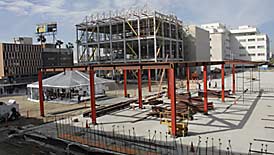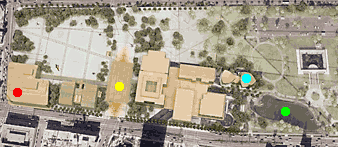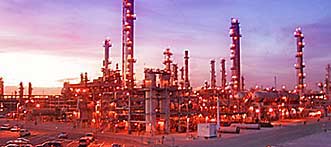[this is reposted from the excellent Art for a Change Blog]

The Los Angeles County Museum of Art (LACMA), after receiving $25 million dollars from the multinational oil company BP (British Petroleum), plans to dedicate a new entry gate and pavilion to the energy Goliath. To be christened the “BP Grand Entrance”, the construction is nothing more than an edifice to big oil and the clearest example yet of the increasing corporatization of the arts in America.Historically, the largesse of wealthy benefactors has always played a role in the arts, with the names of well-heeled patrons gracing museum wings and collections. But there is something unseemly about naming part of an art museum after a transnational oil conglomerate – especially when considering the increasingly toxic role of oil companies in today’s world. President of BP America, Bob Malone, said the donation represents the energy giant’s “commitment to the arts” – but scrutiny of the oil-smeared endowment reveals a public relations campaign designed to erase public memory of BP’s dirty doings.

BP’s contribution will go towards a costly three-part expansion and renovation of LACMA’s facilities. The oil leviathan’s cash has swollen the money available for the first phase construction to $191 million. Italian architect Renzo Piano has won the commission to redesign and unify LACMA’s expansive site. Billionaire Eli Broad and his wife Edythe gave $60 million to the overhaul project. The Broad Contemporary Art Museum, to be built just west of the “BP Grand Entrance”, will connect to LACMA’s existing main wing and will house Eli Broad’s collection of modern art. The new LACMA and its edifice to the petroleum industry, is scheduled to open February of 2008.In a March 6th article on the oil company’s “gift” to LACMA, the Los Angeles Times noted that, “Putting an oil company’s name on LACMA’s doorway brings an unusually high potential for controversy.” Indeed – and here comes the controversy! Despite the endless and well-financed public relations spin concerning BP’s alleged “commitment to sustainable energy”, the fact of the matter is that BP is part of the “OILigarchy” – the rapacious fossil fuel industry responsible for global warming and massive environmental destruction. BP reported profits of $22 billion in 2006, and the company currently has an ongoing commitment to increase its oil production by 5% – a policy that must be linked to the very real crisis of fossil fuel-induced climate change.

BP invests less than 1% of its annual budget in solar and other renewable energy sources – a smaller amount than it spends yearly on public relations and advertising. That fact must be kept in mind, as the “BP Grand Entrance” pavilion will be topped by solar panels allegedly there to help fill LACMA’s energy needs. However, the real task of the solar panels is a propagandistic one. BP wishes to pawn itself off as a green energy company, and LACMA – for a price – is only too happy to collude.As the L.A. Times noted in its March 6th article, BP has paid more than $125 million in legal settlements in the State of California since 2002. Quoting the L.A. Times article, “BP paid the state $45.8 million to settle a suit over pollution from leaking gasoline storage tanks. Later, air quality regulators sued over leakage of smog-forming chemicals at BP’s Carson refinery. BP settled for $81 million.”

In 2005, BP’s Texas City Refinery exploded, killing 15 workers and injuring 170. U.S. government agencies investigating the blast found that BP’s excessive safety and budget cuts had led to the tragedy. More than 1,700 lawsuits have been filed by injured workers, with some 1,200 claims being settled out of court by BP in order to avoid bad publicity. The oil company has set aside $1.6 billion dollars to settle cases out of court. In the wake of the explosion in Texas, the U.S. Occupational Safety and Health Administration (OSHA), opened investigations into two of BP’s Midwestern refineries, finding the oil giant guilty of violating 39 safety regulations. OSHA issued penalty citations totaling $2.4 million dollars – BP hopes to settle out of court. 
In 2006 BP was forced to shut down half of its oil operations in Prudhoe Bay, Alaska, when the company’s worn-out, corroded pipelines began to leak – dumping an estimated 200,000 gallons of crude oil onto Alaskan tundra. On March 6th, 2007, Reuters reported that “Oil major BP’s failure to maintain pipelines properly at its giant Prudhoe Bay field was a major factor behind Alaska’s worst-ever onshore crude spill last year.” In that same report Reuters interviewed Thomas Barret, the head of the U.S. Department of Transport (one of the U.S. government agencies investigating the spill), who said; “What was most unusual was to have an operator like BP not maintaining these pipelines to the standards we typically see in the industry.”BP is behind the controversial Baku-Tbilisi-Ceyhan (BTC) pipeline – the second longest pipeline in the world – transporting crude oil from fields in the Caspian Sea to the Mediterranean Sea. The pipeline runs across the countries of Azerbaijan, Georgia, and Turkey, all of which are conflict zones with notorious human rights records. BP has signed “production-sharing agreements” with the three host governments, neo-colonial contracts that bypass respective national environmental and social laws and place the overwhelming majority of profits in the hands of BP and its partners.
And speaking of oil pipelines in conflict zones, in 2006 BP secretively paid out a multi-million dollar settlement to Columbian farmers who were terrorized by right-wing death squads “protecting” BP’s 500-mile long Ocensa oil pipeline. A thousand poor Columbian farmers filed a human rights challenge in the High Court of London, charging BP with benefiting from the bullying and persecution meted out by the rightist militias. A Columbian lawyer attempting to assist the farmers discovered she was on a paramilitary death list, and fled to Britain where she was granted political asylum. While the total compensation paid to the farmers is unknown, it is believed to have totaled in the tens of millions of dollars. Part of the settlement stipulated BP would bear “no admission of liability” for the beatings, death threats, and property damage suffered by the farmers.
Of course BP has a long history in the Middle East, where seventy percent of the world’s oil reserves are found. Western powers thirsty for petroleum and a need to control the region’s black gold have historically resorted to colonialism, the backing of dictatorships, the proliferation of weapons, and as we see today in Iraq – outright war and occupation.
During the first week of March, 2007, the Anglo-American backed government of Iraq, approved a draft law that will essentially turn over Iraq’s oil wealth to American and British companies. The Iraqi oil legislation bill promotes a “production-sharing agreement” that would guarantee foreign companies up to 70 percent of the revenues obtained from exploiting Iraqi oil, giving U.S. and British oil companies the unrestricted right to take oil profits out of the country, rather than reinvesting them in Iraq. The lion’s share of Iraq oil profits will therefore go to Shell, ChevronTexaco, ExxonMobil, and yes – BP. The draft law still needs final Iraqi government approval before it can be enacted, but with U.S. and British military might keeping the Iraqi government in power – passage is sure to be a “done deal.”
The roots of BP’s meddling in the Middle East go back to 1909. In that year, through an agreement with the Shah of Iran, the Anglo-Persian Oil Company (APOC) began to exploit the oil resources of Persia, obtaining petroleum that fed the British war machine during World War 1. In 1936 Persia was renamed Iran, and APOC became the Anglo-Iranian Oil Company (AIOC). In 1951 the Iranian parliament passed a bill that nationalized the oil industry, effectively barring British exploitation of Iranian petroleum and causing the Shah – and AIOC – to flee the country. The British then colluded with the U.S. and the C.I.A. to organize the infamous coup that overthrew Iran’s Prime Minister Mohammed Mossadeq and his democratically elected government. On August 19th, 1953, Mossadeq was driven from power, the pro-Western Shah was restored, and in 1954 AIOC became known as The British Petroleum Company (BP) – which of course immediately resumed pumping oil out of Iran.
Credited with such a laundry list of misdeeds, it is not surprising that others have taken notice of BP’s destructive schemes, and have called for resistance to big oil’s sponsorship of the arts. The National Portrait Gallery of London, England, was established in 1856, and it’s the repository for some of that nation’s greatest historic portraits. The gallery holds an annual portrait competition that has launched the careers of several portrait artists. Since 2004 the celebrated competition has been sponsored by none other than BP, and the competition is now known as the “BP Portrait Award.”
In response, English artists and environmental activists started a group called, Art Not Oil, which seeks to end oil industry sponsorship of the arts. The group’s mission statement encourages “artists to create work that explores the damage that companies like BP and Shell are doing to the planet, and the role art can play in counteracting that damage.” The misconduct of BP and other oil companies is continually and determinedly exposed through the art exhibits, educational forums and public protests mounted by the artist activists of Art Not Oil. It is unquestionably time to establish a similar organization in Los Angeles – either that or get used to calling LACMA – The Oil Museum.


